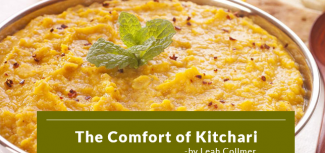
There are six tastes in ayurveda (rasas), for the body and mind to experience. Rasa is a Sanskrit word which also means essence. These six ayurvedic tastes are sweet, sour, salty, pungent (spicy), bitter and astringent.
The ability for the body and mind to experience and perceive taste is an amazing phenomenon. Different areas of the tongue have the ability to sense and decipher different tastes: the tip for sweet, the lower outer sides for sour, the lower center for pungent, mid center and mid outer sides for bitter, the upper outer sides for salty, and the very back of the tongue for astringent.
Just as each of the three doshas (natures or constitutions), Vata, Pitta and Kapha, are comprised of two elements, so is each individual taste, often with one element being more dominant. From these elements, each taste derives its own experience, effects and benefits for the body that not only satiates our hunger, but additionally provides essential qualities, centering body and mind as we navigate life. By knowing the properties of each food you eat, one can better bring balance and harmony into all aspects of one’s life. You can also find here the detailed information about Ayurveda Food for Kapha Prakruti
It is important that each meal should have all the tastes. However, depending on your own prakruti (genetic disposition or inherent nature) and vikruti (current imbalance), different tastes can be more emphasized and others more limited. Additionally, the geographical area you live in along with the present season also influences what the quantity and intensity of rasas (tastes), should be included when preparing a meal.
It is natural that we gravitate towards different tastes. However, these personal preferences aren’t always as beneficial as we’d like to believe. Often a craving, desire or tendency to favor a certain food comes from a place of imbalance within us. To indulge in that craving, perpetuates that imbalance. Eventually, if one continues in this way, this imbalance becomes more extreme allowing different stages of disease to set in. There are different ayurvedic tastes and eating all these six tastes in ayurveda always helps to keep the body in balance. Food is one of our biggest medicines.
In Ayurveda, like increases like. What does this mean? It means that opposites create balance, and like perpetuates its own similar qualities. If we eat something heavy and unctuous that will increase weightiness and oiliness in us. Similarly, if we eat something astringent, that will decrease heaviness and oiliness in us, bringing more dryness and lightness, as these are astringency’s qualities. Ayurveda is a comprehensive system of medicine and there are many health benefits of ayurveda.
Inherently, we like who we are and we like what is familiar to us. That is why we often gravitate towards foods that are similar to us in nature, when we really need the opposite to bring balance. This illustrates why going with what you desire isn’t always a good thing. Eating with a little awareness and discipline can bring long term satisfactory benefits that far outweigh a momentary morsel of the munchies.
It is very important to really taste food and not just consume it as a means to an end to satisfy our hunger. Tasting food itself is a necessary part of the process for the brain and other organs. By chewing thoroughly this allows the tongue to fully experience and revel in all the tastes.
Is made of earth and water. Properties are heavy, cooling, oily. Is grounding and nourishing. Classic examples: rice, milk, oatmeal. Reduces Vata and Pitta. Increases Kapha.
Sour– Is made of earth and fire. Properties are liquid, oily, hot, heavy. Helps the digestive process. Classic examples: limes, lemons, citrus fruits. Reduces Vata. In moderation for Kapha. Increases Pitta.
Salty– Is made of fire and water. Properties are heavy, oily, hot. It is the least hot of all the heating tastes. Increases energy and strength. There are five different forms of salts: sea salt, rock salt (i.e. Himalayan), black salt, salt from sea foam, salt from the earth. Reduces Vata. In moderation for Pitta. Increases Kapha.
Is made of fire and air. Properties are hot, dry, light, sharp, aromatic. Breaks up stagnation. Good for Kapha. Classic examples are hot peppers, paprika, ginger, cayenne. Reduces Kapha. In moderation for Vata. Increases Pitta.You can also find here the detailed information about Ayurveda Food for Pitta Prakruti
Astringent– Is made of air and earth. Properties are dry, cold, heavy. Classic examples are legumes and cruciferous vegetables. Reduces Kapha and Pitta. Increases Vata.
Bitter– Is made of air and space/ether. Properties are cool, light, dry. Classic examples are turmeric, aloe, dandelion greens, fenugreek. Reduces Pitta and Kapha. Increases Vata.
Sweet Foods– Ghee, whole milk, maple syrup, oatmeal, coconuts, dates, figs, mangos, melons, prunes, avocados, beets, carrots, cucumbers, sweet potatoes, winter squash, yams, corn, oatmeal, rice, wheat, almonds, cashews, macadamia nuts and pecans, pumpkin, sesame and sunflower seeds, red lentils, yellow dal (yellow mung), urad dal (black dal, gram or lentil); and spices: anise, fresh, sweet basil (known as Genovese basil), cardamom, coriander, cinnamon, dill, fennel, poppy seeds, rose, saffron. Honey is a food that while sweet, can also be used by Kapha, due to its heating property.
Sour Foods– Buttermilk, sour cream, fresh yogurt, citrus fruits, kiwi, any sour fruits, tamarind, tomatoes, fermented foods.
Naturally Salty Foods– Sea salt, rock salt (i.e. Himalayan), black salt, salt from sea foam, salt from the earth, celery, fish, gomasio, miso, tamari, seaweed, soy sauce. The five salts listed here all are essential for health, and making a blend is a guaranteed way to ensure consumption. (Note that table salt is not included as it is heavily treated and includes additives.)+
Pungent Foods– All peppers are pungent: bell peppers, chili peppers, habaneras, jalapeno, asafetida, cardamom, cayenne, cinnamon, cloves, cumin, ginger, garlic, horseradish kohlrabi, leeks, mustard greens, mustard seeds, onions, radishes, sage, uncooked spinach, turnips, thyme, turmeric, wasabi, , mustard seeds and greens, radishes, peppercorns, buckwheat, spelt.
Bitter Foods – Bitter melon, burdock root, eggplant, collard, dandelion and mustard greens, kale, Jerusalem artichoke, yellow dock, lettuce: butter, green, iceberg, red, romaine, red; black pepper, cacao, cloves, hing, certain caffeinated teas, coffee, cumin, dill, fenugreek, mustard seeds, paprika, saffron. Don’t get excited, though. Ayurveda doesn’t recommend either coffee or chocolate due to their having been very processed, additionally to their nature of blocking deep channels in the body.
Astringent Foods– Rye, apples, particularly green, blueberries, cranberries, berries in general if not very sweet, pears, pomegranate, black, white and green tea, green bananas, broccoli, brussel sprouts, cabbage cauliflower, white potatoes, turmeric, bay leaf, aloe vera, dry basil, coriander, nutmeg, parsley, rosemary, vanilla, the white peel inside citrus fruits, in general beans or lentils, particularly black eyed peas and garbanzo.

Written by: LEAH COLLMER
 Leah Collmer is a certified Wellness Educator, Yoga Teacher, Laughter Yoga Teacher & Trainer and Aroma Therapist. She loves all things Ayurveda, and has a passion for working with children, cooking, ethnic food, and foreign culture. Leah has been writing for over 25 years and has had the great fortune of writing for heads of state, ambassadors, award-winning photo journalists, and non-profits committed to changing the world. Since 2015, she has been in India exploring the depths of the body/mind connection through Ayurveda, Yoga and Meditation. Leah offers practical and productive Life and Wellness Coaching to anyone who is on a path. Love, balance and embracing life is the key for her. Leah’s favorite holiday is Holi Festival and she is deeply grateful to all her teachers who have helped her on her path.
Leah Collmer is a certified Wellness Educator, Yoga Teacher, Laughter Yoga Teacher & Trainer and Aroma Therapist. She loves all things Ayurveda, and has a passion for working with children, cooking, ethnic food, and foreign culture. Leah has been writing for over 25 years and has had the great fortune of writing for heads of state, ambassadors, award-winning photo journalists, and non-profits committed to changing the world. Since 2015, she has been in India exploring the depths of the body/mind connection through Ayurveda, Yoga and Meditation. Leah offers practical and productive Life and Wellness Coaching to anyone who is on a path. Love, balance and embracing life is the key for her. Leah’s favorite holiday is Holi Festival and she is deeply grateful to all her teachers who have helped her on her path.
If you are looking for Ayurveda Nutrition Courses in Kerala, contact Greens Ayurveda right away. Call us at +91 496 2504334 now!!
Embed This Image On Your Site (copy code below):
 The Comfort Of Kitchari By Leah Collmer
The Comfort Of Kitchari By Leah Collmer
Everyone loves c...
 The Tongue Scraper – Ayurveda’s Secret Tool by Leah Collmer
The Tongue Scraper – Ayurveda’s Secret Tool by Leah Collmer
The idea of tongue scraping might sound primitiv...
 Tips To Beat Summer Heat – Ayurvedic Way By Leah Collmer
Tips To Beat Summer Heat – Ayurvedic Way By Leah Collmer
It’s summer ti...
 The Comfort Of Kitchari By Leah Collmer
The Comfort Of Kitchari By Leah Collmer
Everyone loves c...
 The Tongue Scraper – Ayurveda’s Secret Tool by Leah Collmer
The Tongue Scraper – Ayurveda’s Secret Tool by Leah Collmer
The idea of tongue scraping might sound primitiv...
 Tips To Beat Summer Heat – Ayurvedic Way By Leah Collmer
Tips To Beat Summer Heat – Ayurvedic Way By Leah Collmer
It’s summer ti...
 The Comfort Of Kitchari By Leah Collmer
The Comfort Of Kitchari By Leah Collmer
Everyone loves c...

Certified Wellness Educator, Yoga Teacher, Laughter Yoga Teacher & Trainer and Aroma Therapist